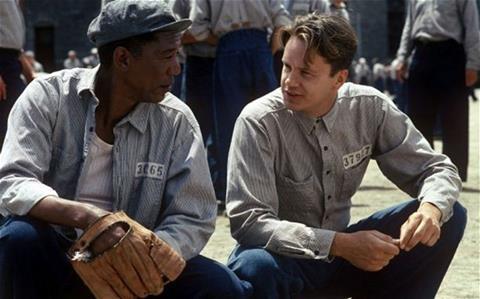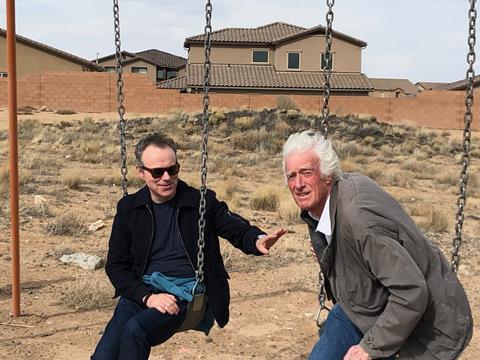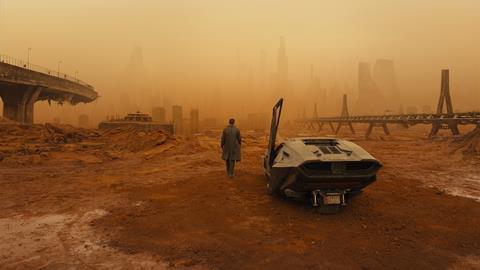Looking back on almost 50 years of iconic films, ranging from The Shawshank Redemption and The Big Lebowski to Skyfall and Blade Runner 2049, the British cinematographer discusses his creative approach and his life in pictures.
It irritates Roger Deakins to be called an artist. Cinematographers do not create art, he says: “We are storytelling. I help directors to tell the story they want in visual imagery.”
It’s a typically no-nonsense and modest response from the Devonshire-born filmmaker who is nonetheless a master of his profession. Famously nominated for 14 Oscars (eventually landing one this year for Blade Runner 2049) and first choice collaborator for directors Sam Mendes, Denis Villeneuve and the Coen brothers, the sixty-eight-year-old member of the British Society of Cinematographers (BSC) and its US counterpart is declared by former President of the ASC, Richard Crudo, “the pre-eminent cinematographer of our time.”

What stands out in a 46-year career spanning iconic films like Deadman Walking, The Shawshank Redemption, The Big Lebowski and Skyfall is Deakins’ grounding in the visual, rather than the technical aspects, of the role.
“I certainly think there is an obsession with technical abilities at the expense of creativity and substance,” he says. “If you can light and photograph the human face to bring out what’s within that person, you can do anything.”
A natural painter who continues to sketch frequently while working out shot composition, Deakins has also been an avid photographer since childhood – indeed he might have become a photojournalist had his path not led to film school.
It was at Bath School of Art and Design, studying graphic design, that his passion for still photography took over and hastened a decision to enrol at the National Film and Television School. On graduation, he spent seven years travelling the world making documentaries.
One might think there is quite a gap between ‘run and gun’ documentary realism and the designed, rehearsed and infinitely larger scale production of a dramatic feature but for Deakins the progression was natural.
‘I like cinema to be like seeing a picture on a wall, as if you walked into a gallery and saw an Edvard Munch painting coming alive’
“Certainly, on a feature film you can create a set and create the lighting and adapt what is in front of you to help tell a story in a more fictional way, but throughout my career I have used the techniques I learned through taking still photographs and making documentaries. I don’t see the two as dissimilar.
“The docs I made were generally unscripted and we would attempt to portray a situation, whether the aftermath of conflicts in Zimbabwe or Eritrea or more anthropological [such as ceremonial traditions of the Raj Gond in India] as truthfully as you can. That’s similar to features where you are working out how best to cover a scene. It’s an intuitive reaction to what is front of you. Sometimes you get the chance of another take, but often you do not. There will be something about the actor’s performance or about the existing light which will be unique, and you have to capture that.”
His first major feature film collaboration was with director Michael Radford on Nineteen Eighty-Four, a 1984 adaptation of Orwell’s novel, which Deakins still ranks among his own best work.
“It was the scale of the challenge and the brilliance of what Mike did with that film,” he says. “His vision for the film matched what I took from the novel and it was very much in tune with the culture and politics of the time.”
There followed a succession of acclaimed British indie features including Personal Services, Stormy Monday and Sid and Nancy, before Deakins shot his first Hollywood production, Mountains of the Moon for Bob Rafelson in 1990. Shortly afterwards he met Joel and Ethan Coen, lensed Barton Fink, and inked an inseparable creative partnership on their films including Fargo, No Country for Old Men and Hail Caesar!

“With any director I’ll discuss the choice of location and sets and discuss the way the camera might move and lens length, and how subjective or objective the camera might be,” Deakins says. “I usually start off with a thorough read of the script, literally reading line by line but each director will have their own way of working – some prefer to be extremely thorough in advance [like the Coens], others want the spontaneity of doing it all on the day.
“A cinematographer has to be able to run a crew and take them on a journey,” he explains. “When I began I was actually quite shy, so working with large crews was daunting at first but it’s a very fundamental part of the job. You also need to make decisions very fast. In some ways a director can spend a little more time making decisions than their DP, who has to make sure that what the director decides, happens.”
Unlike many DPs who assign themselves a camera operator, Deakins prefers to get behind the camera himself, another legacy of his grounding in documentaries.
“I find that being involved with the camera and the way it moves is important to the way I work. It’s more important than lighting really.”

Likewise, his approach to recording digitally hasn’t altered his approach. “It’s a bit more reassuring seeing the image you are shooting on-set and knowing what it is you recorded rather than receiving it from the lab the next morning, but the mechanics of working with a camera and a lens haven’t changed. You are still working with light and camera movement to give the audience a perspective on the story.”
What digital has enabled, he says, is a reduction in the size and portability of the camera and therefore the speed of image capture. However, he is generally dismissive of latest image enhancements like ultra-high resolution, higher frame rates and higher dynamic range.
Having supervised the HDR transfer of films he has shot, for Blu Ray release, he says, “In theory it’s nice to have that range. In reality, it makes the image kind of crude and superficial. I am not a fan.”
He adds, “There are so many new ways of telling stories visually. I like digital, but I am a purist. I don’t like 3D or other immersive technology. I like cinema to be like seeing a picture on a wall, as if you walked into a gallery and saw an Edvard Munch painting coming alive.”
Deakins though is no techno-refusenik. He has shot digital almost exclusively for the last six years and isn’t nostalgic about the demise of film; “I love film… but things move on.”
You might think the advance of technologies for automating the extraction of scene metadata for deciding focus, framing and exposure in post are anathema to someone like Deakins whose modus operandi is to create the ‘look’ of a film in camera.
“I am actually surprised that this hasn’t happened already and that we still use a camera with a lens,” he says. “This technology is kind of old fashioned.”

Having lent his expertise as consultant to the look of a number of animated features including WALL: E and How to Train Your Dragon, Deakins doesn’t see a fundamental difference between computational cinematography and his goal of telling a story.
“An animated film is created in a computer by placing a virtual camera anywhere you want and putting a light anywhere you want. It can be as photoreal as you want it to be. I feel that this kind of animated production will merge and blend with live action at some point.”
Love of film
Growing up in Torquay, Deakins had no connection to the business “or with [TV / film] artists and certainly no expectation of working in the arts.” But he loved film.
He joined a film club and was exposed to French new wave filmmakers Jean-Luc Godard and Alain Resnais, themselves influenced by the work of Jean-Pierre Melville whom Deakins also admired.
He recalls the impression made on him by The War Game, a BBC TV drama directed by Peter Watkins about nuclear war, decreed so unsettling it was banned by the UK government for 20 years.
“I encountered so many films and filmmakers from the film club. My overriding experience was ‘Wow, what is this!’,” he says. He holds particular appreciation for the distinctive cinematography and mise-en-scène of directors (and their DPs) like Andrei Tarkovsky (Ivan’s Childhood, Stalker) and Kenji Mizoguchi (Ugetsu, The Life of Oharu). Russian director Andrei Zvyagintsev (Leviathan, Loveless) is one of the few filmmakers working today reminiscent to Deakins of this style. “We are in a different world of superhero movies now, where the effect is more theme park than cinema,” he says.
He finds it sad that films are increasingly premiering online (on the small screen) and that hardly anyone in power in Hollywood has seen a movie by Tarkovsky, or Melville or Mizoguchi.

Having wrapped principal photography on The Goldfinch for John Crowley (Brooklyn) starring Nicole Kidman earlier this year, Deakins says he selects projects only if he is emotionally drawn to the story.
“I ask myself whether I’d go and see this in a cinema. Making a film is a long investment of time; it’s always quite hard work with long hours, and an exhausting process if you care about what you are doing. So, I need to feel emotionally invested in the story.”
An occasional speaker at the NFTS when he is in the country, Deakins is always prepared to hand on advice. His website devotes a section to respond to the queries of aspiring cinematographers and peers alike.
“My advice is that you can observe somebody else and they can be an inspiration, but you can’t copy them. You have to discover your own way of doing it.”
One of Deakins heroes was the late Conrad Hall, ASC who lensed Butch Cassidy and the Sundance Kid, American Beauty and Road to Perdition, all of which won him Academy Awards. Hall’s 1972 film, Fat City, influenced Deakins’ decision to shoot movies instead of stills.
“I was excited by his work because he shot more in the Italian neo-realist way more than traditional cinematographers,” he says. “He had a certain eye; a sense of seeing. That is really all you have to offer as a cinematographer. Otherwise, what have you got?”
Deakins’ eye is recognisable across his body of work.
“You spend your life trying to figure out how you see things. You are interpreting what is in front of you. An image is your own in some way. It’s a discovery.”

























2 Readers' comments